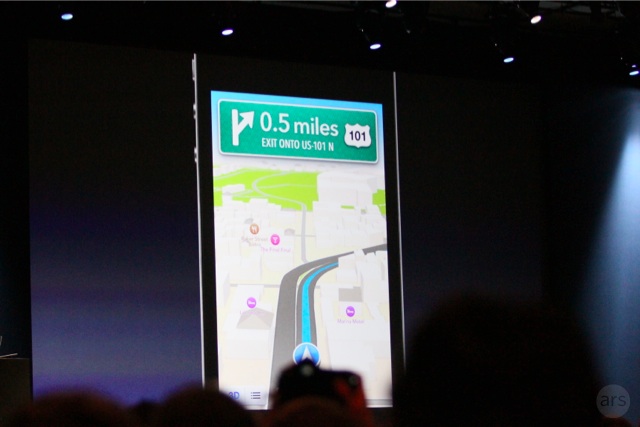
Question: I get that the new Maps in iOS 6 are cool and all, but I really just wanted turn-by-turn navigation so I don't have to buy external apps just so I can drive around and have directions read to me. Why did Apple wait so long to add this feature to Maps, and why did it coincide with the decision to stop using Google's API?
Ars answer: The introduction of Apple's new Maps app for iOS—slated to launch with iOS 6 when it is released in the fall—was a breath of fresh air for most users. The current version of Maps had fallen behind the competition in terms of functionality and cool factor, and many were beginning to get frustrated by what seemed like an old and outdated mapping product. Where were our 3D maps? And why did we have to rely on so many third parties to bring us turn-by-turn navigation?
It's that latter question that is still being asked now that Apple has told us about the next generation of iOS Maps, which ditches Google's API for Apple's own technologies. The new version of Maps for iOS 6 will indeed include turn-by-turn navigation capabilities, similar to those provided by a dedicated GPS unit or the plethora of other apps that became available in the absence of an Apple-provided solution. The application will be able to speak the directions aloud, too, and reroute based on what is happening in real time. Finally, a modern mapping application! But why did such a feature require Apple to divorce itself from Google before it could be implemented?
The most obvious answer to the question lies in the Google Maps API's terms of service itself. Google may offer most of its juicy data to developers for their third-party apps (including Apple), but it does place some restrictions on what kind of applications are allowed to be built using Google's API. And in particular, Google restricts those making apps from its APIs from offering real-time navigation or route guidance in their own apps. Here is the relevant section in the TOS:
10.2 Restrictions on the Types of Applications that You are Permitted to Build with the Maps API(s). Except as explicitly permitted in Section 8 (Licenses from Google to You) or the Maps APIs Documentation, you must not (nor may you permit anyone else to) do any of the following:
[…]
(c) No Navigation, Autonomous Vehicle Control, or Enterprise Applications. You must not use the Service or Content with any products, systems, or applications for or in connection with any of the following:
(i) real time navigation or route guidance, including but not limited to turn-by-turn route guidance that is synchronized to the position of a user's sensor-enabled device.
It looks like Google's terms for use of the API clearly restricts companies like Apple from offering turn-by-turn navigation in their apps. But this leaves at least one unanswered question: what if Apple and Google had worked out their own agreement that isn't necessarily subject to the TOS that are applied to everyone else?
Indeed, this remains a possibility—one that neither company was willing to confirm with us. When asked about whether Apple was specifically restricted from offering turn-by-turn navigation while using Google's mapping API, an Apple spokesperson declined to comment. Google did not respond to our requests for comment at all. As one of our commenters (name99) pointed out in a discussion thread on Monday: "Google and Apple are huge companies. Whatever deal they negotiated between themselves is going to remain secret. If you're hoping for Larry and Sergei to write a blog post explaining what Apple can and can't do, you'll be waiting a long time."
Indeed, we'll likely never know whether Apple and Google had worked out their own deal. And without that knowledge, we'll have to accept what we do know: that Google (at least) restricts most parties from offering some features based on its Maps APIs. Apple has decided to move on—likely for that and other reasons. Apple has spent years acquiring various mapping companies so that it could build what it believes is the next-generation of mobile maps, and turn-by-turn navigation is just the beginning.
Placebase, a company that Apple bought in July of 2009, was known for its PushPin API that offered richer data integration features than those offered through Google. Poly9 came next in July of 2010 with its Google Earth clone and the brainpower behind NORAD's Santa Claus tracking site. In 2011, Apple acquired C3 Technologies, known for its 3D maps that we now know are a major part of the new iOS 6 Maps. It's clear that Apple has been working on replacing Google Maps for a while now, and the public will find out soon enough whether Apple's own solution will allow the kind of flexibility the company is hoping for by getting out from under Google's wing.
reader comments
99